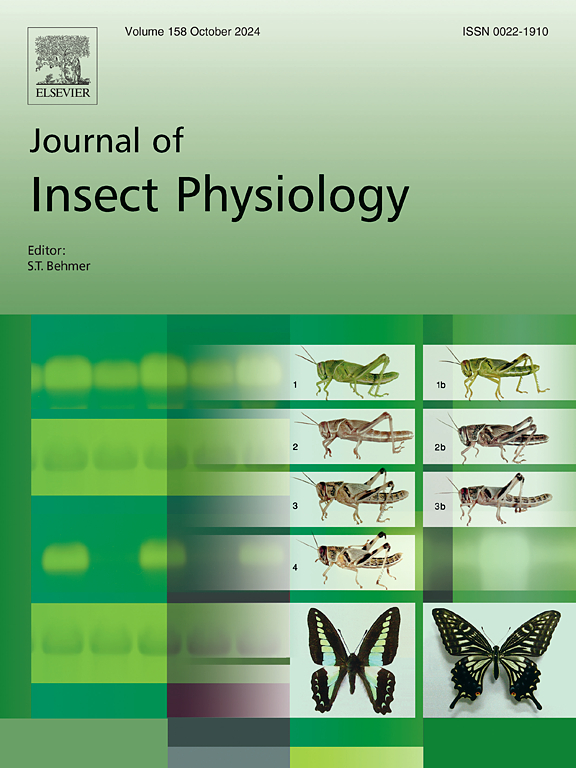蜜蜂在变暖、饥饿和新烟碱下的应激反应
IF 2.3
2区 农林科学
Q1 ENTOMOLOGY
引用次数: 0
摘要
蜜蜂是世界上最重要的作物传粉者,但它们的数量最近出现了显著下降,可能是由于多种压力因素。蜜蜂和其他昆虫依靠热休克蛋白(HSP)和抗氧化防御系统来缓冲来自温度上升、饥饿和农药暴露等挑战的潜在有害影响。然而,我们对压力源如何影响蜜蜂生理的理解,以及热休克蛋白和抗氧化剂在多大程度上保护蜜蜂免受生物分子损伤的理解仍然不完整。在本研究中,我们采用全因子实验设计,研究了三种应激源(温度升高、饥饿和暴露于两个实际剂量的新烟碱类杀虫剂吡虫啉)对蜜蜂热休克蛋白水平、总抗氧化能力和抗脂质氧化损伤的抗氧化保护作用的单独和联合影响。我们发现在所有测试条件下,脂质过氧化和总抗氧化能力之间存在正相关关系,表明抗氧化剂保护氧化损伤的能力有限。此外,当蜜蜂单独暴露于饥饿或温度升高时,对脂质过氧化的抗氧化保护作用得到改善,但当两种应激源同时存在时,这种抗氧化保护作用减弱,这表明高温和饥饿联合暴露具有拮抗作用。这些发现提供了证据,表明暴露于多种压力源可能会通过压倒性的抗氧化防御产生亚致死效应。我们讨论了这些结果对蜜蜂种群管理的潜在影响,特别是在全球环境变化的背景下,以确保蜜蜂的健康并保护它们提供的基本生态系统服务。本文章由计算机程序翻译,如有差异,请以英文原文为准。

Stress response of the honey bee exposed to warming, starvation and neonicotinoids
Honey bees are the world’s most important crop pollinators, but their populations have recently shown significant declines, likely due to multiple stressors. Bees and other insects rely on heat shock proteins (HSP) and antioxidant defense systems to buffer against potentially noxious effects coming from challenges such as rising temperatures, starvation, and pesticide exposure. Nevertheless, our understanding of how combined stressors impact honey bee physiology, and the extent to which HSPs and antioxidants can protect against biomolecular damage, remains incomplete. In our study, we examined the isolated and combined effects of three stressors (temperature increase, starvation, and exposure to the neonicotinoid insecticide imidacloprid at two realistic doses) on HSP levels, total antioxidant capacity, and antioxidant protective effect against lipid oxidative damage in Apis mellifera ligustica, using a full factorial experimental design. We found a positive relationship between lipid peroxidation and total antioxidant capacity throughout all conditions tested, indicating a limited capacity of antioxidants to protect against oxidative damage. Moreover, when bees were exposed to starvation or increased temperature alone, the antioxidant protective effect against lipid peroxidation was improved, but when both stressors were present together such an antioxidant protective effect was reduced, suggesting an antagonist effect of combined exposure to heat and starvation. These findings provide evidence that exposure to multiple stressors may produce sublethal effects by overwhelming antioxidant defenses. We discuss potential implications of these results for the management of honey bee colonies, particularly in the context of global environmental change, to ensure the health of honey bees and protect the essential ecosystem services they provide.
求助全文
通过发布文献求助,成功后即可免费获取论文全文。
去求助
来源期刊

Journal of insect physiology
生物-昆虫学
CiteScore
4.50
自引率
4.50%
发文量
77
审稿时长
57 days
期刊介绍:
All aspects of insect physiology are published in this journal which will also accept papers on the physiology of other arthropods, if the referees consider the work to be of general interest. The coverage includes endocrinology (in relation to moulting, reproduction and metabolism), pheromones, neurobiology (cellular, integrative and developmental), physiological pharmacology, nutrition (food selection, digestion and absorption), homeostasis, excretion, reproduction and behaviour. Papers covering functional genomics and molecular approaches to physiological problems will also be included. Communications on structure and applied entomology can be published if the subject matter has an explicit bearing on the physiology of arthropods. Review articles and novel method papers are also welcomed.
 求助内容:
求助内容: 应助结果提醒方式:
应助结果提醒方式:


